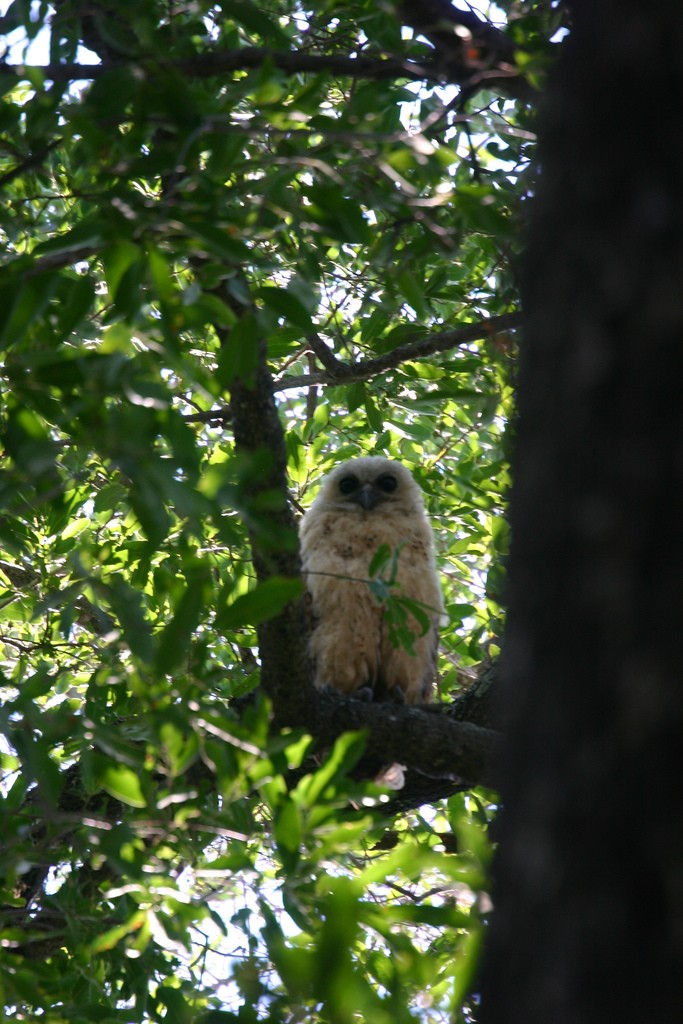Pel's Fishing Owl
A species of Fishing Owls Scientific name : Scotopelia peli Genus : Fishing Owls
Pel's Fishing Owl, A species of Fishing Owls
Botanical name: Scotopelia peli
Genus: Fishing Owls
Content
Description General Info
 Photo By Oztenphoto , used under CC-BY-SA-2.0 /Cropped and compressed from original
Photo By Oztenphoto , used under CC-BY-SA-2.0 /Cropped and compressed from original Description
Pel's fishing owl is one of the largest owl species in the world. Among the world's owls, it ranks as the fifth heaviest on average, the seventh longest in length and measured wing chord and fourth longest in mean wingspan, although not all large species have had measured wingspans. It measures 51–63 cm (20–25 in) in length, spans around 153 cm (60 in) across the wings and weighs up to at least 2.35 kg (5.2 lb). One male was found to weigh 1.72 kg (3.8 lb) and four females averaged 2.19 kg (4.8 lb), it may outrival the snowy owl (only around 4% lighter on average in six datasets) as the fifth or sixth heaviest living owl on average. Under current classification, it is the heaviest extant owl outside of the genus Bubo, although some authors may also include the fishing owls in Bubo. Among standard measurements, the wing chord is 40.7–44.7 cm (16.0–17.6 in) and the tail is 20.7–24.3 cm (8.1–9.6 in) long. They are well adapted to their aquatic lifestyle. Unlike most owls, they have minimal feathering on the toes and the tarsus, thus minimizing the amount of plumage that gets wet while fishing. Like diurnal raptors that specialize in fish, they have spiky scales on the bottoms of their feet that help them grip slippery fish. Since hearing and auditory stealth is not important to its hunting techniques, this owl does not have strong hearing and does not have the soft edges to its flight feathers that most owls share, which makes them almost impossible to hear in flight. Adults are colored a rich ginger-rufous with dense dark bars to the upperparts and scaling to the underparts. The feathers around the head are loose and long, giving the head a shaggy appearance. The tarsi and toes are unfeathered and straw-colored. The white throat is often largely obscured but can be puffed up in displaying birds during courtship. The flight and tail feathers are barred with lighter and darker feathers. The eyes are distinctly dark, often blackish in color. The two adult sexes are similar looking but females are generally less rufous in color and have a more indistinct facial disc. There is considerable variation in coloration and barring in adult birds, with some birds having extensive pale feathers with others having several blackish markings. Juveniles are more uniform buff than adults. Unlike the eagle-owls, the ear tufts of the Pel's fishing owl are barely visible, giving it a very round-headed appearance. The two related fishing owls are smaller and lack the dark barring and scaling (though they do have dark streaks below). The song of the male Pel's fishing owl is a deep, sonorous, horn-like boom, first a single and then a higher pitched huhuhu. The male also utters a ringed hoot, much higher pitched than those of most eagle-owls, followed by a deep, soft grunt: whoommmm-wot or hooomm-hut. The calls of the male are repeated every 10 to 20 seconds and can be heard from up to 3 km (1.9 mi) away. While singing, the male's throat and breast are often highly inflated. The female's songs are similar but are higher pitched and even in a double-note, i.e. hoot-oot. Females and young at the nest wail a shrill wheeoouu while anticipating food. 
Size
63 cm
Nest Placement
Tree
Feeding Habits
Pel's Fishing Owl primarily consumes a variety of fish, from small 100-200g to larger 2kg specimens, including occasional frogs, crabs, mussels, large insects, and even baby Nile crocodiles. Pel's Fishing Owl detects prey from perches by observing water ripples, then snatches them with talons without significant submersion, a unique hunting technique among piscivorous birds.
Habitat
Pel's Fishing Owl thrives in sub-Saharan Africa, inhabiting riverine forests along water bodies, such as rivers, estuaries, and lakes. They seek mature trees for cover in regions from sea level up to 1,700 m. Typically sedentary, pel's Fishing Owl necessitates proximity to abundant water and dense vegetation, avoiding arid zones.
Dite type
Carnivorous
General Info
Feeding Habits
Bird food type
Behavior
In general, this species is nocturnal and is most vocally active on moonlit nights, especially near dawn. However, they are sometimes seen to be active during the day, especially when prey is scarce. During the daytime, they usually roost on a large tree branch. Often, the male and female roost together. At dusk, they leave the roost and instead perch on stumps, branches and other objects that extend over the water. 
Distribution Area
It is found throughout a large part of sub-Saharan Africa, but it is generally rather local, uncommon and absent from drier regions. It is patchily distributed in Nigeria, Senegal, the Gambia, Guinea, Sierra Leone and in central Africa from the coast to eastern Zaire and discontinuously to South Sudan, Somalia, Kenya and Tanzania and southwards to Zimbabwe, Botswana and eastern South Africa. The Pel's fishing owl is found in forests along rivers and lakes. They can found in swamps and estuaries at sea level up to an elevation of around 1,700 m (5,600 ft). Their favorite habitat is riverine forests with large trees, although large numbers are also found on islands with large, old trees within larger rivers, swamps or lakes, so long as the islands are not too far from the bank. The species is largely residential and has no seasonal movement, although young, non-breeding birds may wander somewhat before claiming their own territories. Pel's fishing owl may move outside of their own range in pursuit of prey. 
Species Status
Not globally threatened.
Scientific Classification
Phylum
Chordates Class
Birds Order
Owls Family
True owls Genus
Fishing Owls Species
Pel's Fishing Owl